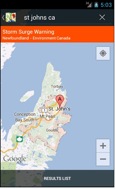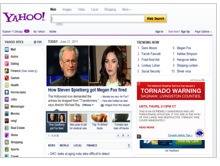As one of the outcomes of the CAP Implementers workshops, Eliot Christian has prepared an article that we publish hereafter.
By Eliot Christian
To help disseminate public warnings, alerting authorities have long relied on commercial media, such as newswire services, broadcast radio and television. Many television stations insert “crawl text” with the warning message, and radio stations insert a recording. This public-private collaborative effort required huge investments in specialized technology, and decades to implement.

Now the public uses online media more and more. Do societies worldwide need a new round of huge investments in specialized technology so that people online can get public warnings? Actually, huge new investments are not necessary. Online media and alerting authorities already have developed an effective way to get public warnings to people online, and at minimal cost.

For example, Google now shows official warnings to desktop and mobile users of Google Search and Google Maps. A high priority warning will show for the specific alerting area, taking into account what the user is doing and his/her own settings. This Google Public Alerts service today shows warnings from Environment Canada and Public Safety Canada (in English and French), and from the U.S. National Weather Service and the U.S. Geological Survey. But, Google could do the same for warnings from any alerting authority, worldwide. The Google Public Alerts service just needs to monitor Internet news feeds where the alerts use the Common Alerting Protocol (CAP) standard.
Here is another example of warnings being shown to people online. ValueClick, one of the world’s largest online advertising companies, interrupts commercial advertising to show tornado warnings. Like Google, ValueClick only shows these warnings to users in the alerting area. Those warnings are shown with eye-catching graphics, and in the user’s own language.

Here too, these powerful online public warnings can be implemented worldwide: everywhere that people use the Internet. Huge investments in new technology are not required –just that alert feeds use the CAP standard (officially designated as ITU?T Recommendation X.1303). For an alerting authority like the U.S. National Weather Service, public dissemination by Google and ValueClick costs nothing extra. Prior to CAP, weather alert messages were mostly text and that makes them difficult for weather customers to process with computer systems. Because CAP makes processing much easier, National Weather Service users prefer CAP as their primary alert message format. Users of alerts across other natural and man-made hazard types have the same experience: it is much easier to use alerts in the CAP format. Without CAP, such users have to deal with free text or with different formats that vary across hazard types, and across countries as well. The lack of a standard made it almost impossible to implement all?hazard, all-media public alerting.
Now that we have the CAP standard, effective and efficient alerting systems promise great benefits for relatively modest investments. With CAP-based alerting, an alert sender activates multiple warning systems with a single trigger–reducing cost and complexity when employing a range of warning mechanisms (sirens, pagers, electronic highway signs, e-mail, web sites, etc). For emergency managers, CAP is also useful for compiling standardized alerts from many sources, enabling pattern detection and “situational awareness”. On one map, emergency managers can monitor the whole situation: all types of local, regional, and national alerts, integrated through CAP. (This example is from Canada’s Multi-Agency Situational Awareness Systems, MASAS). CAP is not a complex standard to implement. You can think of CAP as a “standard form” a page with various fill-in boxes and check boxes giving specific details of the alert. The power of CAP is simply in standardizing those form boxes.
For instance, any alert message must specify the alerting area. There are many ways to define an area, but CAP chose a particular way. The alerting area in CAP is either a circle or a polygon shape, with decimal latitude / longitude points. Standardizing how to represent the alerting area, just one of those fill-in boxes on the CAP standard “alert form”, is a great help to those who need to exchange alerting information. Using “coded values” like polygons, rather than free text, makes CAP much easier to interface with automated systems. Of course, humans need natural language text in addition to codes, and CAP does provide for such text, in any language. Alerting authorities typically implement CAP as an add-on feature to their current alerting processes. They publish a copy of the alert, in CAP format, on their own Internet news feed. Internet media like Google and ValueClick then constantly monitor that news feed so they can automatically disseminate critical warnings to online users in the alerting area. Online media companies, journalists, and others need to know which CAP feeds are official. For that there is the international Register of Alerting Authorities, maintained by the World Meteorological Organization (WMO) and the International Telecommunication Union (ITU). Now we see that all the parts are in place to achieve dramatic improvements in public warning for societies worldwide. Nations like Australia, Canada, Germany, South Africa, the United States, and several Caribbean islands already have CAP running. Across Europe, CAP weather alerts are being produced in 35 languages (although they are not shown publicly yet). China, Japan, and other countries are implementing CAP right now as well. Building on the global Internet infrastructure, the Google Public Alerts initiative and the efforts of ValueClick have demonstrated how voluntary public-private collaboration can provide a powerful public service. Hopefully, CAP-based public warning for online users will be implemented by other online advertising systems like DoubleClick, and other online media such as Microsoft, Apple, Yahoo, Facebook, Twitter, Baidu, etc. Perhaps Internet browsers (Microsoft Internet Explorer, Mozilla Firefox, Google Chrome, Apple Safari) will also offer an option for users to have a built-in CAP-based warning service.
You can read more on how to adopt the CAP standard by looking to this PREZI.


